Jiankang Deng
RetouchLLM: Training-free White-box Image Retouching
Oct 09, 2025Abstract:Image retouching not only enhances visual quality but also serves as a means of expressing personal preferences and emotions. However, existing learning-based approaches require large-scale paired data and operate as black boxes, making the retouching process opaque and limiting their adaptability to handle diverse, user- or image-specific adjustments. In this work, we propose RetouchLLM, a training-free white-box image retouching system, which requires no training data and performs interpretable, code-based retouching directly on high-resolution images. Our framework progressively enhances the image in a manner similar to how humans perform multi-step retouching, allowing exploration of diverse adjustment paths. It comprises of two main modules: a visual critic that identifies differences between the input and reference images, and a code generator that produces executable codes. Experiments demonstrate that our approach generalizes well across diverse retouching styles, while natural language-based user interaction enables interpretable and controllable adjustments tailored to user intent.
Embodied Arena: A Comprehensive, Unified, and Evolving Evaluation Platform for Embodied AI
Sep 18, 2025Abstract:Embodied AI development significantly lags behind large foundation models due to three critical challenges: (1) lack of systematic understanding of core capabilities needed for Embodied AI, making research lack clear objectives; (2) absence of unified and standardized evaluation systems, rendering cross-benchmark evaluation infeasible; and (3) underdeveloped automated and scalable acquisition methods for embodied data, creating critical bottlenecks for model scaling. To address these obstacles, we present Embodied Arena, a comprehensive, unified, and evolving evaluation platform for Embodied AI. Our platform establishes a systematic embodied capability taxonomy spanning three levels (perception, reasoning, task execution), seven core capabilities, and 25 fine-grained dimensions, enabling unified evaluation with systematic research objectives. We introduce a standardized evaluation system built upon unified infrastructure supporting flexible integration of 22 diverse benchmarks across three domains (2D/3D Embodied Q&A, Navigation, Task Planning) and 30+ advanced models from 20+ worldwide institutes. Additionally, we develop a novel LLM-driven automated generation pipeline ensuring scalable embodied evaluation data with continuous evolution for diversity and comprehensiveness. Embodied Arena publishes three real-time leaderboards (Embodied Q&A, Navigation, Task Planning) with dual perspectives (benchmark view and capability view), providing comprehensive overviews of advanced model capabilities. Especially, we present nine findings summarized from the evaluation results on the leaderboards of Embodied Arena. This helps to establish clear research veins and pinpoint critical research problems, thereby driving forward progress in the field of Embodied AI.
LMAD: Integrated End-to-End Vision-Language Model for Explainable Autonomous Driving
Aug 17, 2025Abstract:Large vision-language models (VLMs) have shown promising capabilities in scene understanding, enhancing the explainability of driving behaviors and interactivity with users. Existing methods primarily fine-tune VLMs on on-board multi-view images and scene reasoning text, but this approach often lacks the holistic and nuanced scene recognition and powerful spatial awareness required for autonomous driving, especially in complex situations. To address this gap, we propose a novel vision-language framework tailored for autonomous driving, called LMAD. Our framework emulates modern end-to-end driving paradigms by incorporating comprehensive scene understanding and a task-specialized structure with VLMs. In particular, we introduce preliminary scene interaction and specialized expert adapters within the same driving task structure, which better align VLMs with autonomous driving scenarios. Furthermore, our approach is designed to be fully compatible with existing VLMs while seamlessly integrating with planning-oriented driving systems. Extensive experiments on the DriveLM and nuScenes-QA datasets demonstrate that LMAD significantly boosts the performance of existing VLMs on driving reasoning tasks,setting a new standard in explainable autonomous driving.
Unlocking the Potential of Diffusion Priors in Blind Face Restoration
Aug 12, 2025
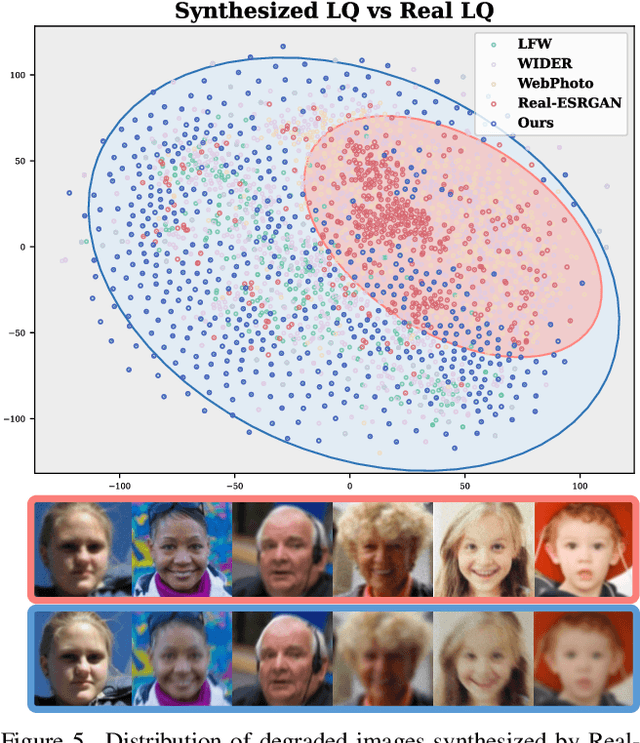
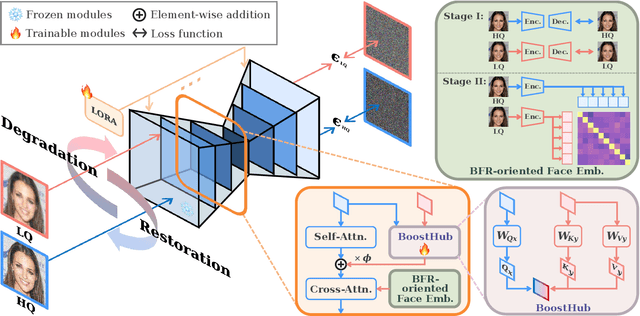
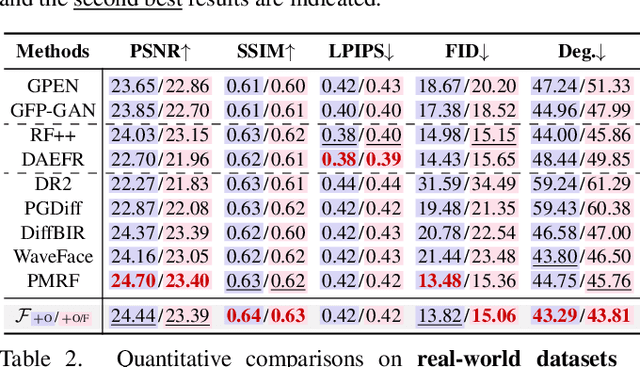
Abstract:Although diffusion prior is rising as a powerful solution for blind face restoration (BFR), the inherent gap between the vanilla diffusion model and BFR settings hinders its seamless adaptation. The gap mainly stems from the discrepancy between 1) high-quality (HQ) and low-quality (LQ) images and 2) synthesized and real-world images. The vanilla diffusion model is trained on images with no or less degradations, whereas BFR handles moderately to severely degraded images. Additionally, LQ images used for training are synthesized by a naive degradation model with limited degradation patterns, which fails to simulate complex and unknown degradations in real-world scenarios. In this work, we use a unified network FLIPNET that switches between two modes to resolve specific gaps. In Restoration mode, the model gradually integrates BFR-oriented features and face embeddings from LQ images to achieve authentic and faithful face restoration. In Degradation mode, the model synthesizes real-world like degraded images based on the knowledge learned from real-world degradation datasets. Extensive evaluations on benchmark datasets show that our model 1) outperforms previous diffusion prior based BFR methods in terms of authenticity and fidelity, and 2) outperforms the naive degradation model in modeling the real-world degradations.
Region-based Cluster Discrimination for Visual Representation Learning
Jul 26, 2025Abstract:Learning visual representations is foundational for a broad spectrum of downstream tasks. Although recent vision-language contrastive models, such as CLIP and SigLIP, have achieved impressive zero-shot performance via large-scale vision-language alignment, their reliance on global representations constrains their effectiveness for dense prediction tasks, such as grounding, OCR, and segmentation. To address this gap, we introduce Region-Aware Cluster Discrimination (RICE), a novel method that enhances region-level visual and OCR capabilities. We first construct a billion-scale candidate region dataset and propose a Region Transformer layer to extract rich regional semantics. We further design a unified region cluster discrimination loss that jointly supports object and OCR learning within a single classification framework, enabling efficient and scalable distributed training on large-scale data. Extensive experiments show that RICE consistently outperforms previous methods on tasks, including segmentation, dense detection, and visual perception for Multimodal Large Language Models (MLLMs). The pre-trained models have been released at https://github.com/deepglint/MVT.
Breaking the Modality Barrier: Universal Embedding Learning with Multimodal LLMs
Apr 24, 2025Abstract:The Contrastive Language-Image Pre-training (CLIP) framework has become a widely used approach for multimodal representation learning, particularly in image-text retrieval and clustering. However, its efficacy is constrained by three key limitations: (1) text token truncation, (2) isolated image-text encoding, and (3) deficient compositionality due to bag-of-words behavior. While recent Multimodal Large Language Models (MLLMs) have demonstrated significant advances in generalized vision-language understanding, their potential for learning transferable multimodal representations remains underexplored.In this work, we present UniME (Universal Multimodal Embedding), a novel two-stage framework that leverages MLLMs to learn discriminative representations for diverse downstream tasks. In the first stage, we perform textual discriminative knowledge distillation from a powerful LLM-based teacher model to enhance the embedding capability of the MLLM\'s language component. In the second stage, we introduce hard negative enhanced instruction tuning to further advance discriminative representation learning. Specifically, we initially mitigate false negative contamination and then sample multiple hard negatives per instance within each batch, forcing the model to focus on challenging samples. This approach not only improves discriminative power but also enhances instruction-following ability in downstream tasks. We conduct extensive experiments on the MMEB benchmark and multiple retrieval tasks, including short and long caption retrieval and compositional retrieval. Results demonstrate that UniME achieves consistent performance improvement across all tasks, exhibiting superior discriminative and compositional capabilities.
"Principal Components" Enable A New Language of Images
Mar 11, 2025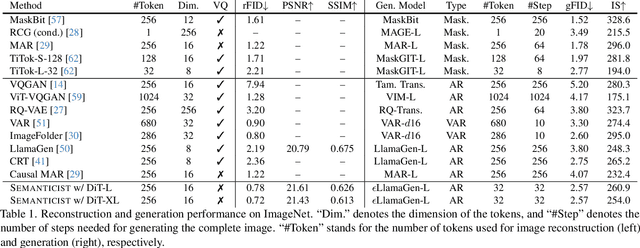

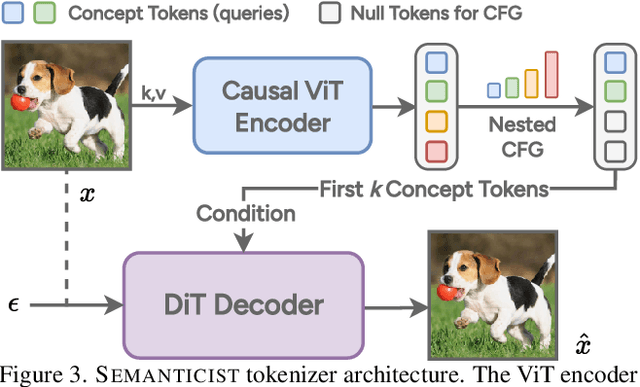
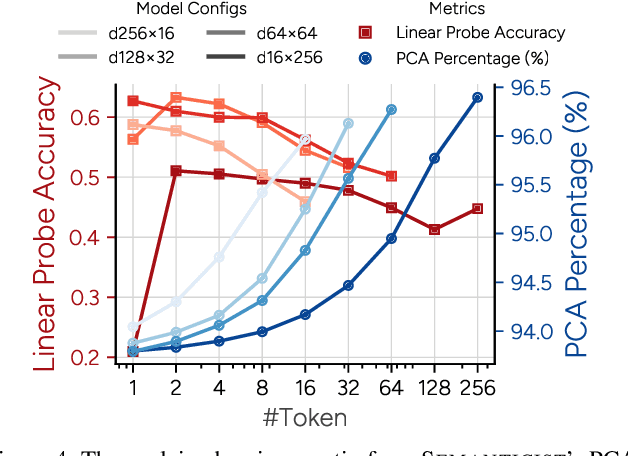
Abstract:We introduce a novel visual tokenization framework that embeds a provable PCA-like structure into the latent token space. While existing visual tokenizers primarily optimize for reconstruction fidelity, they often neglect the structural properties of the latent space -- a critical factor for both interpretability and downstream tasks. Our method generates a 1D causal token sequence for images, where each successive token contributes non-overlapping information with mathematically guaranteed decreasing explained variance, analogous to principal component analysis. This structural constraint ensures the tokenizer extracts the most salient visual features first, with each subsequent token adding diminishing yet complementary information. Additionally, we identified and resolved a semantic-spectrum coupling effect that causes the unwanted entanglement of high-level semantic content and low-level spectral details in the tokens by leveraging a diffusion decoder. Experiments demonstrate that our approach achieves state-of-the-art reconstruction performance and enables better interpretability to align with the human vision system. Moreover, auto-regressive models trained on our token sequences achieve performance comparable to current state-of-the-art methods while requiring fewer tokens for training and inference.
General Force Sensation for Tactile Robot
Mar 02, 2025



Abstract:Robotic tactile sensors, including vision-based and taxel-based sensors, enable agile manipulation and safe human-robot interaction through force sensation. However, variations in structural configurations, measured signals, and material properties create domain gaps that limit the transferability of learned force sensation across different tactile sensors. Here, we introduce GenForce, a general framework for achieving transferable force sensation across both homogeneous and heterogeneous tactile sensors in robotic systems. By unifying tactile signals into marker-based binary tactile images, GenForce enables the transfer of existing force labels to arbitrary target sensors using a marker-to-marker translation technique with a few paired data. This process equips uncalibrated tactile sensors with force prediction capabilities through spatiotemporal force prediction models trained on the transferred data. Extensive experimental results validate GenForce's generalizability, accuracy, and robustness across sensors with diverse marker patterns, structural designs, material properties, and sensing principles. The framework significantly reduces the need for costly and labor-intensive labeled data collection, enabling the rapid deployment of multiple tactile sensors on robotic hands requiring force sensing capabilities.
RealSyn: An Effective and Scalable Multimodal Interleaved Document Transformation Paradigm
Feb 18, 2025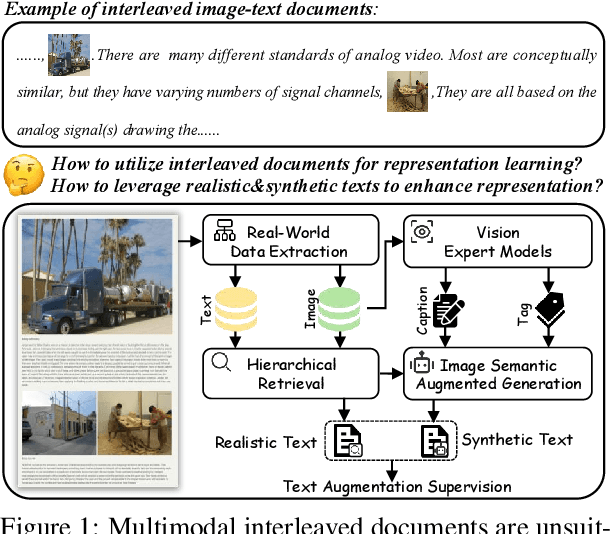

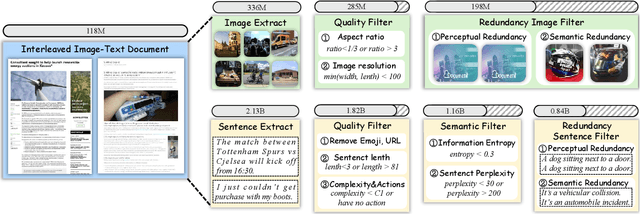

Abstract:After pre-training on extensive image-text pairs, Contrastive Language-Image Pre-training (CLIP) demonstrates promising performance on a wide variety of benchmarks. However, a substantial volume of non-paired data, such as multimodal interleaved documents, remains underutilized for vision-language representation learning. To fully leverage these unpaired documents, we initially establish a Real-World Data Extraction pipeline to extract high-quality images and texts. Then we design a hierarchical retrieval method to efficiently associate each image with multiple semantically relevant realistic texts. To further enhance fine-grained visual information, we propose an image semantic augmented generation module for synthetic text production. Furthermore, we employ a semantic balance sampling strategy to improve dataset diversity, enabling better learning of long-tail concepts. Based on these innovations, we construct RealSyn, a dataset combining realistic and synthetic texts, available in three scales: 15M, 30M, and 100M. Extensive experiments demonstrate that RealSyn effectively advances vision-language representation learning and exhibits strong scalability. Models pre-trained on RealSyn achieve state-of-the-art performance on multiple downstream tasks. To facilitate future research, the RealSyn dataset and pre-trained model weights are released at https://github.com/deepglint/RealSyn.
Chirpy3D: Continuous Part Latents for Creative 3D Bird Generation
Jan 07, 2025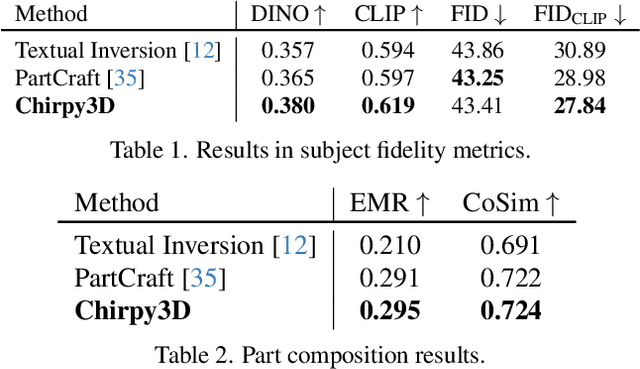
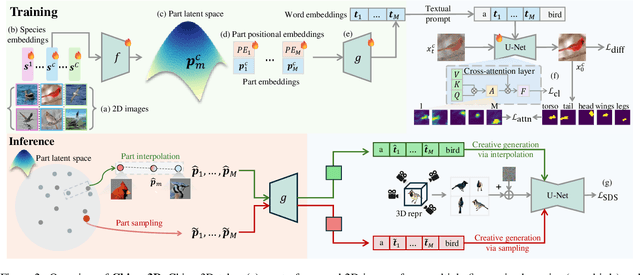
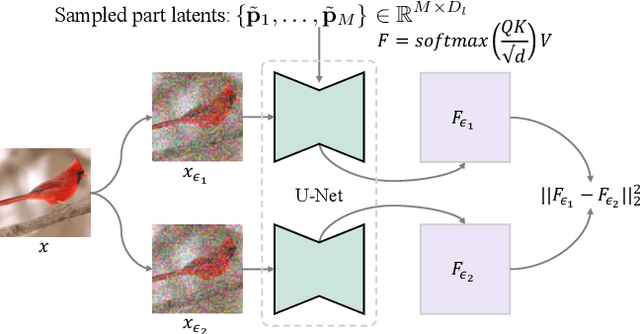

Abstract:In this paper, we push the boundaries of fine-grained 3D generation into truly creative territory. Current methods either lack intricate details or simply mimic existing objects -- we enable both. By lifting 2D fine-grained understanding into 3D through multi-view diffusion and modeling part latents as continuous distributions, we unlock the ability to generate entirely new, yet plausible parts through interpolation and sampling. A self-supervised feature consistency loss further ensures stable generation of these unseen parts. The result is the first system capable of creating novel 3D objects with species-specific details that transcend existing examples. While we demonstrate our approach on birds, the underlying framework extends beyond things that can chirp! Code will be released at https://github.com/kamwoh/chirpy3d.
 Add to Chrome
Add to Chrome Add to Firefox
Add to Firefox Add to Edge
Add to Edge